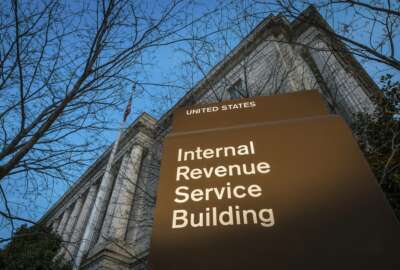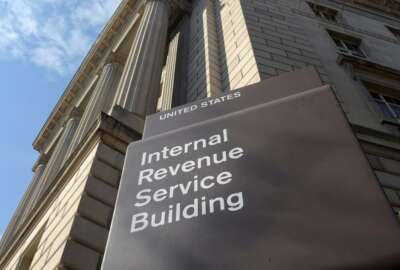
IRS, seeing shortfall of volunteers, considers recalling more employees
Professional Managers Association President Chad Hooper said some areas of the IRS mission are moving ahead, but others will take “a very long time” to return...
This story was updated Thursday, May 5 at 2:42 p.m. to include comments from the National Treasury Employees Union.
IRS employees returning to work in Kansas City, Missouri, have access to a room that’s full of masks and hand sanitizer, but workers in suburban New York, facing shortages of personal protective equipment in the area, have been told to still bring their own masks from home.
In Fresno, California, the agency has hired new cadres of employees remotely. In Austin, Texas, the agency has trained employees to telework for the first time.
In Andover, Massachusetts, the agency has rolled out equipment to call-center employees so they can respond to taxpayer calls while working from home.
In Philadelphia, however, the limited capacity of an antiquated server means employees can’t forward calls from the office when they’re on telework.
When it comes to reopening the IRS and resuming normal operations amid the coronavirus, Chad Hooper, the president of the Professional Managers Association, which represents agency supervisors, said some areas of the mission are moving ahead, but the pandemic has put other operations on hold.
The IRS, for example, has been able to reprogram a 60-year old mainframe to issue more than 130 million pandemic stimulus payments within its first month.
And yet, in other areas, such as reopening in-person Taxpayer Assistance Centers, Hooper told reporters in a video briefing on Wednesday that it will be “a very long time” before the agency can ensure those services can resume safely.
Read more: Workforce News
And while IRS managers earlier in the pandemic were given the flexibility to make personnel decisions, he said they’re also worried about giving advice that may not be the right call, especially at a time when official recommendations can change quickly and become outdated.
“None of my peers are public health experts, and a lot of what we know, we’ve learned from the CDC website, just like everyone else,” Hooper said.
That guidance, he added, leaves much to interpretation. If for example, an employee keeps touching the front of their mask with their hands, how often should they wash their hands?
And if employees don’t comply with the guidance in the office, what discretion do supervisors have to send them home?
“If a manager gives misinformation or is just sharing the best information that they have at the time and make some mistake, or it wasn’t the best call, will that manager be personally liable for the risks that now they’ve brought into government?” Hooper said.
11,000 asked to return to office, maybe more
Last month, Hooper said IRS asked about 11,000 employees to volunteer to return to work in the office to handle essential mission-critical work for the tax filing season, which now ends on July 15.
That work includes answering phones, processing mail and other essential work they can’t complete while teleworking.
However, Hooper said not all 11,000 employees have returned yet, and added that the IRS has discussed recalling more employees into the office as early as next Monday.
National Treasury Employees Union President Tony Reardon said that the IRS is “seeking additional volunteers” to return to the workplace while the agency continues to operate under its evacuation order.
The union, he added, supports the agency’s effort to bring employees back to work through incentive pay, as long as the IRS takes steps to ensure social distancing, provide hand sanitizer and increase workplace cleaning to follow CDC recommendations.
In order to “alleviate pressure on taxpayers and the agency,” Reardon said NTEU has called on the IRS to extend the tax filing season deadline to Oct. 15.
IRS Commissioner Chuck Rettig told congressional staff late last month that 100 agency employees had contracted the coronavirus, and four had died.
Reardon said an IRS employee in Kansas City tested positive for the coronavirus this week.
“It is unsurprising that IRS employees, like many Americans, are apprehensive about returning to their worksites,” he said. “In addition to health concerns, many have small children at home and limited options for child care. We will continue to work with the IRS to find the right balance between delivering a tax filing season and keeping federal employees safe.”
NTEU has estimated that 44% of the IRS workforce continues to telework during the pandemic.
While the IRS has yet to provide a breakdown of how many continue to work out of the office, Hooper noted that 30,000 IRS employees that have been originally placed on administrative leave during the pandemic, although he said that number has gone down.
Read more: Management News
Meanwhile, many IRS employees throughout the pandemic have shown up to the office to conduct essential tasks or retrieve paperwork from their offices, which the evacuation order permits,
In order to practice social distancing, Hooper said IRS has limited most buildings to 50% capacity and employees in the office work at every other workstation.
The has limited elevators to two employees at a time, and staff now hold up their credentials to security guards, rather than hand them over.
“Physically, it is easy for us to comply with the social distancing of staying six feet apart,” Hooper said.
Employees who have returned, Hooper said, have mixed emotions. Some, he said, are worried about the infection risk, but he said the majority of those returning are doing it “out of a concern for their community.”
“They want to know that the mail is being opened and the checks are being deposited. There is a civic call to duty whenever you’re working in the civil service. We’re not compensated handsomely to do this kind of work, and so that attitude and concern for one another, I think is what’s driving many folks to come back in,” Hooper said.
Pay boost may continue long term but levels vary
Hooper previously said IRS employees who volunteered to return to work will receive retention pay for at least two pay periods, “with increased pay based on the risk level of their role.”
But he said that a temporary pay boost may continue “going forward in the longer term.” The IRS, he added, has even discussed the possibility of Special Act awards reserved for employees whose work “contributes to the efficiency, economy, or other improvement of government operations.”
But even the rate of retention pay for employees will vary. On the low end, Hooper said some employees may see an incentive that’s 10% of their pay but others, such as those who work in the mailrooms, that rate could look like 25% of their pay.
“Employees who work in the mailroom have a risky job all year long. We receive all sorts of things in the mail that are dangerous or hazardous, just by nature of the kind of agency that we are and the number of people that we interact with,” Hooper said.
The pay incentives are meant to serve as a kind of hazard pay, but aren’t hazard pay in the legal sense, Hooper said, since the IRS has a policy that prevents employees that have faced disciplinary actions in the past or are on a Performance Improvement Plan aren’t eligible for hazard pay.
Copyright © 2025 Federal News Network. All rights reserved. This website is not intended for users located within the European Economic Area.
Jory Heckman is a reporter at Federal News Network covering U.S. Postal Service, IRS, big data and technology issues.
Follow @jheckmanWFED
Related Stories

IRS sees surge of visitors to site tracking coronavirus stimulus payments




